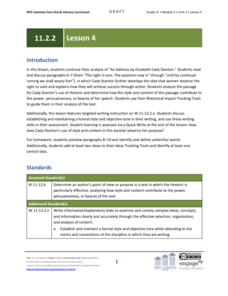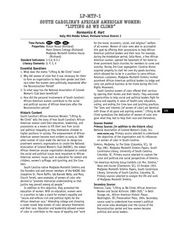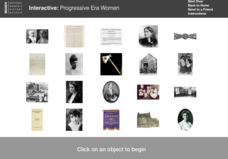DC Vote
One Kid, One Vote
Learn about why the citizens of Washington, D.C. feel unrepresented in Congress with an article about D.C voting rights. Individuals read about the movement toward congressional representation in Washington, D.C., before answering...
National History Day
Challenging the Status Quo: Women in the World War I Military
Why are some so resistant to change? The status quo is often to blame for a lack of forward movement in society. Following the events of World War I, women in America suddenly had a voice—and were going to use it. Scholars use the second...
EngageNY
Grade 11 ELA Module 2: Unit 2, Lesson 3
What is the distinction between rights and equality? Scholars continue their analysis of "An Address by Elizabeth Cady Stanton" using the third instructional activity from the 14-part Grade 11 ELA Module 2: Unit 2 series. Pupils complete...
EngageNY
Grade 11 ELA Module 2: Unit 2, Lesson 4
How does style contribute to the power and persuasiveness of a speech? With the question in mind, scholars continue reading "An Address by Elizabeth Cady Stanton." They complete a Rhetorical Impact Tracking Tool to guide them in their...
EngageNY
Grade 11 ELA Module 2: Unit 2, Lesson 7
Joan of Arc, Mother Teresa, Rosa Parks ... many inspirational women have paved the way for future generations, and Elizabeth Cady Stanton is no exception. Scholars continue reading and analyzing "An Address by Elizabeth Cady Stanton."...
EngageNY
Grade 11 ELA Module 2: Unit 2, Lesson 8
Using the resource, pupils consider how the author structures her argument in "An Address by Elizabeth Cady Stanton." Scholars complete a written response to identify one of Cady Stanton's claims and analyze how she uses reasoning and...
Curated OER
Expansion and Reform: Applying the Declaration of Independence
Students conduct inquiries and research-acquiring, organizing, analyzing, interpreting, evaluating, and communicating facts, themes, and general principles operating in American history. They use the Declaration of Independence to...
Curated OER
South Carolina's African American Women: "Lifting As We Climb"
Middle schoolers explore the formation of the National Association of colored Women's Club. In this civil rights lesson, students research the history and mission of the NACWC.
Curated OER
1912: The Election that Changed the Century
The presidential election of 1912 was a turning point in American politics. Whoever won would reshape the political spectrum. Learn about the key issues, each party's politics, and the four men who wanted to become president: William...
Education World
Every Day Edit - Women Get the Vote
In this everyday editing worksheet, students correct grammatical mistakes in a short paragraph about suffrage. The errors range from punctuation, capitalization, grammar, and spelling.
Curated OER
Voting and the U.S. Constitution (Past, Present, and Future), Part 2
Students analyze and discuss the 19th Amendment, and read the document, Why Women Want to Vote. Students illustrate statements from the handbill, then conduct a play about women's suffrage.
Curated OER
Votes for Women
In this 20th century events learning exercise, students read about the voting rights earned by women in the 20th century. Students learn the terms suffrage and suffragettes. Students answer 4 questions about the information.
Curated OER
Women in Progressive Era
Learners study the Progressive Era. They identify the important people, places, and evens of the Era and determine how women influenced the progressive movement. In addition, they create an article to address issues related to the movement.
Curated OER
Suffragettes 1903-1913
For this suffragettes worksheet, learners read 4 passages about the suffragettes and women's fight to earn the right to vote. Students use a glossary to help them understand the passages.
Curated OER
Susan B. Anthony and the 19th Amendment
Students take a closer look at the Women's Suffrage Movement in America. In this women's rights lesson, students research suffrage leaders and write papers about them. Students then read and discuss information about Susan B. Anthony's...
Curated OER
Voices: Voting Rights
Students examine the history of the right to vote in the United States. In this civics lesson plan, students research steps taken during the Civil Rights Movement to secure the rights of African Americans to vote.
PBS
Women's History: Parading Through History
Want to teach your pupils about debate, effective speech techniques, propaganda, and the women's movement? The first in a sequential series of three, scholars analyze real propaganda images from the the historic women's movement, view a...
Heritage Foundation
Voting and the Constitution
How difficult was it for everyone to get voting rights? Understanding voting rights and the fight to get them for everyone in the United States can be tricky for some learners. However, they are clarified after engaging in the...
National Constitution Center
Voting Rights since the Fifteenth Amendment
What does it mean to have the right to vote? To what extent have interpretations of the Fifteenth Amendment changed over time? Young historians examine and analyze primary source documents, an interactive website, and historical analysis...
Center for Civic Education
Lesson 1: Who Can Vote in the United States?
The purpose of this first lesson in a series of five about enfranchisement and suffrage is to determine what class members already know, or think they know, about voting and voter registration. Groups answer questions on the provided...
EngageNY
Main Ideas in Informational Text: Analyzing a Firsthand Human Rights Account for Connections to Specific Articles of the UDHR
Lesson 10 in a series of human rights lessons focuses on the skills of finding evidence and summarizing. Your young readers work to compare the two texts they have read in this unit: the Universal Declaration of Human Rights...
National Woman's History Museum
Progressive Era Women
The National Women's History Museum provides this interactive resource that permits users to explore women who played key roles during the Progressive Era in the quest for workers' rights, the Settlement House Movement, the Suffrage...
University of North Carolina
Political Science
The right to vote and freedom of expression are democratic principles that fall under the study of political science. A handout describes writing assignments that are common in political science college classes and gives tips and...
National Endowment for the Humanities
The Omnipotence of the Majority
While the American system is based on the idea of almost-universal suffrage for adults, great thinkers have had concerns about this system of governance. Using classic writings from Alexis de Tocqueville and videos highlighting thinkers...
Other popular searches
- Women's Suffrage
- Black Suffrage
- Womens Suffrage
- Abolition and Suffrage
- 13th Amendment Womens Suffrage
- Suffrage Movement
- African American Suffrage
- Women Suffrage
- Women's Suffrage Slogans
- Woman Suffrage
- Women's Suffrage Movement
- Male Suffrage

























